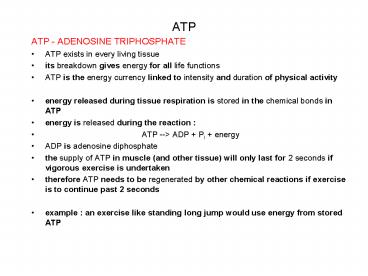ATP PowerPoint PPT Presentation
1 / 8
Title: ATP
1
ATP
- ATP - ADENOSINE TRIPHOSPHATE
- ATP exists in every living tissue
- its breakdown gives energy for all life functions
- ATP is the energy currency linked to intensity
and duration of physical activity - energy released during tissue respiration is
stored in the chemical bonds in ATP - energy is released during the reaction
- ATP --gt ADP Pi energy
- ADP is adenosine diphosphate
- the supply of ATP in muscle (and other tissue)
will only last for 2 seconds if vigorous exercise
is undertaken - therefore ATP needs to be regenerated by other
chemical reactions if exercise is to continue
past 2 seconds - example an exercise like standing long jump
would use energy from stored ATP
2
ATP
- RESYNTHESIS OF ATP
- ATP is resynthesised from ADP within the
following reaction - energy ADP Pi ---gt ATP
- this is an endothermic reaction - energy is given
to the molecule to enable the reaction to happen - this energy will be derived from food fuels
- there are 3 main systems by which this
resynthesis occurs
3
ATP / PC SYSTEM - THE PHOSPHOCREATINE SYSTEM
- ATP / PC SYSTEM
- for activity which lasts between 3 and 10 seconds
- for high intensity maximum work
- example flat out sprinting - 100m sprint
- no oxygen is needed - ANAEROBIC
4
ATP / PC SYSTEM - THE PHOSPHOCREATINE SYSTEM
- ATP is resynthesised via phosphocreatine (PC)
- PC is stored in muscle cell sarcoplasm
- the following reactions takes place
- PC ---gt Pi C energy
- energy ADP Pi ---gt ATP
- the net effect of these two coupled reactions is
- PC ADP ---gt ATP C
- PC is recreated in muscle cells during the
recovery process - this requires energy and is an endothermic
reaction
5
ATP / PC SYSTEM - THE PHOSPHOCREATINE SYSTEM
- EFFECTS OF TRAINING ON THE ALACTIC ANAEROBIC
SYSTEM - muscle cells adapt by
- increase in ATP and PC stores
- therefore the ATP / PC system provides energy for
slightly longer - when exercise is taken at maximum effort
- the alactic / lactic threshold is delayed
6
THE LACTIC ACID SYSTEM
- THE LACTIC ACID SYSTEM
- depends on a chemical process called GLYCOLYSIS
- glycolysis is the breakdown of sugar
- carbohydrate is stored as GLYCOGEN in the muscles
and liver - the breakdown of glycogen provides
- the energy to rebuild ATP from ADP
- this process is ANAEROBIC and takes place in the
SARCOPLASM of the muscle cell - no oxygen is needed
- the end product of this reaction (in the absence
of oxygen) is lactic acid
7
THE ENERGY CONTINUUM
- THE ENERGY CONTINUUM
- this describes the process by which ATP is
regenerated via the different energy systems - depending on the intensity and duration of
exercise - each of the PC, lactic acid and aerobic systems
contribute some ATP during the performance of all
sports - one or other of the energy systems usually
provides the major contribution for a given
activity - the diagram shows approximate proportions of ATP
resynthesised via aerobic / anaerobic for some
sporting activities
8
THE ENERGY CONTINUUM
- OTHER FACTORS AFFECTING THE PROPORTIONS OF ENERGY
SYSTEMS - used in any given exercise activity are
- level of fitness (whether adaptations to training
have included enhancement of relevant enzymes -
which would for example postpone levels of
lactate accumulation) - availability of O2 and food
- fuels, for example a high CHO
- diet would assist replenishment
- Of glycogen stores which would
- then be available for glycolysis
- VARIATION IN CONTRIBUTION OF ENERGY SYSTEMS
- as time progresses during intense exercise,
the following chart shows the contribution
of the different energy systems to the
resynthesis of ATP

